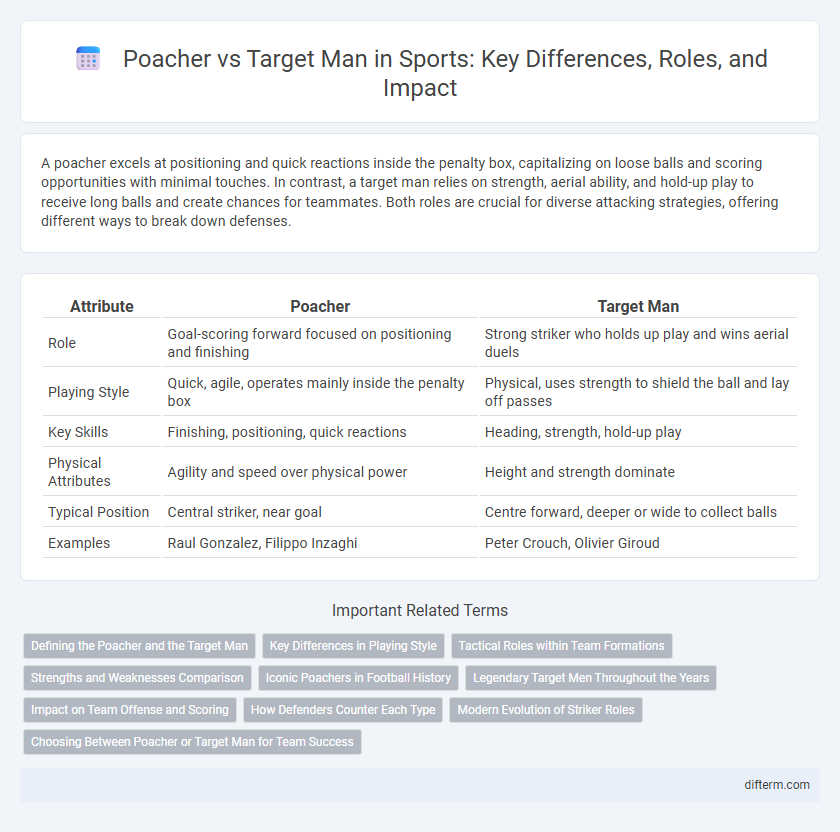A poacher excels at positioning and quick reactions inside the penalty box, capitalizing on loose balls and scoring opportunities with minimal touches. In contrast, a target man relies on strength, aerial ability, and hold-up play to receive long balls and create chances for teammates. Both roles are crucial for diverse attacking strategies, offering different ways to break down defenses.
Table of Comparison
| Attribute | Poacher | Target Man |
|---|---|---|
| Role | Goal-scoring forward focused on positioning and finishing | Strong striker who holds up play and wins aerial duels |
| Playing Style | Quick, agile, operates mainly inside the penalty box | Physical, uses strength to shield the ball and lay off passes |
| Key Skills | Finishing, positioning, quick reactions | Heading, strength, hold-up play |
| Physical Attributes | Agility and speed over physical power | Height and strength dominate |
| Typical Position | Central striker, near goal | Centre forward, deeper or wide to collect balls |
| Examples | Raul Gonzalez, Filippo Inzaghi | Peter Crouch, Olivier Giroud |
Defining the Poacher and the Target Man
A poacher is a striker known for their opportunistic goal-scoring ability, often operating within the penalty area to exploit rebounds and defensive errors. The target man, by contrast, is a physically imposing forward who excels at holding up the ball, winning aerial duels, and creating scoring opportunities by linking play with teammates. Both roles are pivotal in a team's attacking strategy, with the poacher focusing on finishing chances and the target man facilitating build-up play.
Key Differences in Playing Style
Poachers excel in quick positioning, sharp anticipation, and instinctive goal-scoring inside the penalty area, relying heavily on agility and opportunism. Target men, by contrast, use physical strength, aerial prowess, and hold-up play to control long balls and distribute to teammates, often acting as focal points in attack. The poacher thrives in exploiting defensive lapses, while the target man anchors the offensive buildup with a more robust, combative approach.
Tactical Roles within Team Formations
Poachers excel in exploiting goal-scoring opportunities through quick positioning and sharp finishing inside the penalty area, playing a crucial role in counter-attacking formations. Target men serve as focal points in team strategies, using their physical presence to hold up the ball, win aerial duels, and facilitate link-up play in systems like 4-4-2 or 3-5-2. Coaches deploy poachers in high-pressing tactics to capitalize on defensive errors, while target men are integral to build-up play and creating space for midfielders and wingers.
Strengths and Weaknesses Comparison
A poacher excels in quick reactions and positioning, capitalizing on loose balls and tight spaces with sharp finishing skills, making them lethal inside the penalty box but often lacking in physical presence and aerial ability. In contrast, a target man thrives on strength, hold-up play, and aerial duels, effectively linking up with teammates and creating opportunities, yet they can be less agile and slower in exploiting tight defensive lines. Both roles complement different attacking strategies, with poachers favoring speed and precision and target men emphasizing physical dominance and distribution.
Iconic Poachers in Football History
Iconic poachers in football history, such as Gerd Muller and Filippo Inzaghi, are celebrated for their exceptional goal-scoring instincts and ability to capitalize on opposition errors within the penalty area. Unlike target men who excel in physical presence and aerial duels, poachers thrive on sharp positioning and quick reactions to convert chances. Their legacy is defined by prolific goal tallies and moments of clinical finishing that often changed the course of matches.
Legendary Target Men Throughout the Years
Legendary target men like Alan Shearer, Peter Crouch, and Didier Drogba have defined their roles with physical presence, aerial dominance, and hold-up play, creating opportunities for teammates and finishing chances from crosses. Unlike poachers who rely on positioning and quick reactions within the box, target men excel at winning headers and shielding the ball under pressure. Their contribution extends beyond goals, as they facilitate link-up play and maintain attacking shape in various tactical systems.
Impact on Team Offense and Scoring
A poacher thrives in penalty areas, capitalizing on rebounds and loose balls to increase scoring opportunities, significantly boosting a team's conversion rates during critical moments. In contrast, a target man excels at holding up play, creating space, and delivering precise headers or lay-offs to teammates, thereby facilitating build-up and diversifying offensive strategies. The integration of both roles can enhance overall team offense by combining clinical finishing with effective ball distribution in attacking thirds.
How Defenders Counter Each Type
Defenders counter poachers by maintaining tight marking and cutting off quick, opportunistic runs inside the penalty area to limit scoring chances. Against target men, defenders use physical strength and aerial duels to disrupt hold-up play and prevent knockdowns or flick-ons. Effective defensive strategies involve adapting positioning and anticipation to neutralize the distinct threat posed by each striker type.
Modern Evolution of Striker Roles
Modern striker roles have evolved to blend the traditional poacher's instinctual goal-scoring ability with the target man's physical presence and aerial prowess. Poachers thrive in quick, intelligent positioning around the penalty box, capitalizing on rebounds and tight spaces, while target men are crucial for holding up play and linking midfield buildup through strength and heading accuracy. Contemporary tactics often require strikers to interchange these roles, enhancing team fluidity and increasing offensive unpredictability.
Choosing Between Poacher or Target Man for Team Success
Choosing between a poacher or a target man depends on the team's tactical approach and offensive strategy. Poachers excel in quick goal-scoring inside the penalty box, leveraging agility and positioning, while target men provide aerial strength, hold-up play, and assist in set-piece situations. Teams aiming for rapid counterattacks may prefer poachers, whereas sides focusing on possession and buildup rely on target men to create scoring opportunities.
poacher vs target man Infographic

 difterm.com
difterm.com